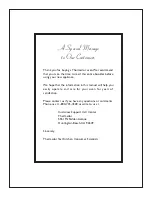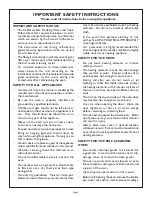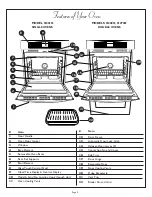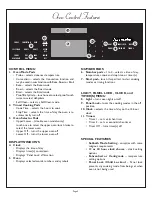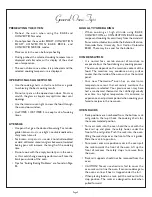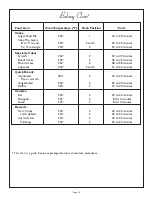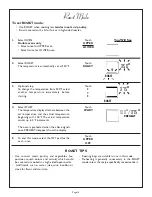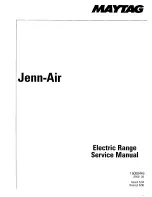
PREHEATING THE OVEN
• Preheat the oven
when using the B AKE and
CONVECTION modes.
• Do not preheat the oven
for ROAST, CONVECTION
ROAST, CONVECTION B AKE, BROIL, and
CONVECTION BROIL modes.
• Place racks in the oven before preheating.
• During preheat the selected cooking temperature is
displayed and alternates with a display of the actual
oven temperature.
• The oven chimes once
when it is preheated and the
selected cooking temperature is displayed.
OPERATIONAL SUGGESTIONS
• Use the cooking charts
in this Care & Use as a guide
to achieving the best cooking results.
• Do not set pans on the opened oven door. Pans may
scratch the glass or liquids may spill into door vent
openings.
• Use the interior oven light
to view the food through
the oven door window.
• Use TIMER 1 OR TIMER 2 to keep track of cooking
times.
UTENSILS
• Use pans that give the desired browning. For tender,
golden brown crusts,
use light nonstick/anodized or
shiny metal utensils.
• For brown, crisp crusts,
use dark nonstick/anodized
or dark, dull metal utensils or glass bakeware. Insulated
baking pans
will increase the length of the cooking
time.
• Do not cook with the empty broiler pan in the oven,
as this could change cooking performance. Store the
broil pan outside of the oven.
• Tips for “Solving Baking Problems” are found on Page
35.
General Oven Tips
HIGH ALTITUDE BAKING
• When cooking at high altitude using BAKE,
CONVECTION, or CONVECTION BAKE
modes,
recipes and cooking times will vary from the standard.
For accurate information, write the Extension Service,
Colorado State University, Fort Collins, Colorado
80521. There may be a cost for the bulletins.
CONDENSATION
• It is normal for a certain amount of moisture to
evaporate from the food during any cooking process.
The amount depends on the moisture content of the
food. The moisture may condense on any surface
cooler than the inside of the oven, such as the control
panel.
• Your new Thermador
®
oven has an electronic
temperature sensor that accurately maintains the
temperature selected. Your previous oven may have
had a mechanical thermostat that drifted gradually
over time to a higher temperature. It is common to
experience an adjustment period when cooking your
favorite recipes in the new oven.
OVEN RACKS
• Rack positions are numbered from the bottom rack
rail guide to the top. Check the cooking charts for
the recommended position.
• To insert racks into the oven, hold the rack with the
back rail up and place the safety hooks under the
front of the rail guides. Push the rack into the oven,
lifting the rack stops over the front of the rail guides.
Slide the rack into position.
• To remove racks or
reposition racks in the oven, pull
the rack towards the front of the oven. Lift up the
front of rackover the safety stops to remove from
the oven.
• Rack rail supports should not be removed from the
oven.
• CAUTION! Never use aluminum foil to cover the
oven racks or to line the oven.
It can cause damage to
the oven can liner if heat is trapped under the foil.
• When placing food on a rack,
pull the rack out to the
stop position. The racks are designed to lock when
pulled forward.
Page 9


